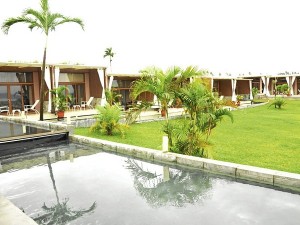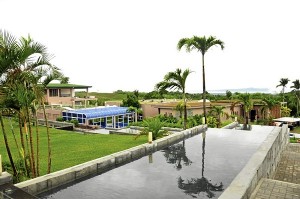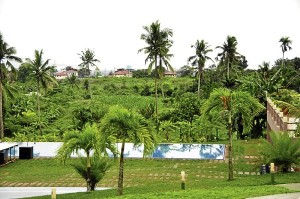Why you should take notice of the retirement phenomenon

AN EXAMPLE of a retirement village is Saujana in Silang which has housing structures in earth colors that deflect heat, and designed to consume minimal electricity. Photo by Tessa R. Salazar
First in a series
Anyhow one looks at it, retirement is a serious matter. The person retiring not only brings with him or her the accumulated financial savings earned from decades of being a productive member of society. The retiree is also laden with the wisdom of having lived life to the fullest.
It would be perfectly understandable, then, why retirees sometimes take a lifetime to ponder over where to spend the next chapter of their lives. And there has been a lot of pondering, lately, as the elderly population steadily increases. There has been discernible growth in the retirement sector for the last several years.
Elderly spending, particularly on the property sector, has been on the rise, fueled mostly by maturing life savings and retirement benefits. But the retirement demographic doesn’t even involve merely the elderly. There have been also younger individuals who plan to retire soon and invest in properties at the same time.
These retirees, whether of “retirable age” or still in the peak of their productive years, are meticulously choosing the places they want to settle into and invest in. This is most evident among the first and second generation of Filipino-American professionals or active retirees who have decided to come home to the Philippines for good.
It is a phenomenon, however, that is not exclusive to the Philippines. The over-60 population worldwide is expected to triple by 2050, according to projections by the United Nations Population Division.
In a retirement warp
Enrique M. Soriano III, Ateneo program director for real estate and senior adviser for Wong+Bernstein Business Advisory, said “The aging population is in a retirement warp.”
Soriano, formerly marketing committee chair of the Philippine Retirement Inc. (the private counterpart of the Philippine Retirement Authority), said this demographic shift will not only provide vast opportunities to capitalize on the talents and skills of older persons, but also create challenges in maintaining financial security for the aging populations.
While a markedly increased aging population is a nearly universal phenomenon, countries are at varying stages in the process. Soriano said the Philippines, along with other countries, is not prepared for the growth spurt of the elderly population.
Ironically, the Philippines has been positioning itself to become the major retirement haven in Southeast Asia for foreigners. But before any massive retiree migration is to take place, infrastructures and services that cater to this sensitive sector need to be either established or finetuned.

THE FACILITY should have adequate facilities and amenities to serve the needs of the retirees. Photo by Tessa R. Salazar
A few years ago, the PRI, in collaboration with the PRA, disclosed to Inquirer Property the accreditation standards for the design and structure of buildings for nursing homes. These standards require provisions for disability access in line with relevant building codes. It was stressed that communal areas would have to be easily accessible by persons with disability and with comprehensive programs that cater to elderly patients who cannot live on their own. The basic structures to be followed cover primary facilities and amenities, among others.
Some of those mentioned are:
Big space and wide alleys to allow wheelchairs and beds to move around
Floorings must be made with resilient, nonslip tiles
Gradual access elevation for wheelchairs for a two-story facility. Beyond two stories, an elevator must be available
Mechanized equipment for bedridden retirees
Grab or handle bars in necessary locations like toilets and bathrooms
Priorities
Paul Vincent Chua, Colliers International’s associate director for valuation and advisory services, and the head of consultancy and research, enumerated the priorities of the retirement sector:
The weather or climate of the location;
Accessibility to healthcare;
Distance or accessibility to central locations (i.e. airports, opportunities for work); and,
Accommodations
Claro dG. Cordero Jr., head of research, consulting and valuation of Jones Lang LaSalle Leechiu, said the ideal place for retirement facilities should have the following elements:
Sustainable community-type developments—The facility should have adequate facilities and amenities to serve the needs of the retirees, such as recreational and retail facilities, and oftentimes, the presence of limited right to be employed locally.
Presence and availability of superior and advanced health-related facilities
Highly developed infrastructure (that are well-connected with major cities through direct flights) and telecommunications facilities as well as reliable supply of utilities (water and electricity)
Safety and security
Adaptability of the community to the culture of the retirees—e.g., presence of well-trained personnel fluent in the native language of retirees
Support and assistance of the local government
National Real Estate Association chair Alejandro S. Mañalac noted that considering the basic needs of typical retirees—whether middle-aged active or even medically assisted—there are a few places which he believes would qualify.
“While most people think the quiet and peaceful beaches are the perfect retirement havens, you will be surprised that a lot of these retirees think otherwise.”
He added, “It is nice to stay in a fancy beach house for a few days, watching the sunset, walk on the sand, listen to the waves, however, they don’t want to spend the rest of their lives that way.”
Mañalac stressed that based on the standards set by the Philippine Retirement Authority, aside from several required specific designs of retirement homes, it also has to be near reputable hospitals with adequate and modern medical facilities. A healthy environment is a must, free from both noise and air pollution. It should also be near places of entertainment and exercise.
Next: How big is the retirement phenomenon?
* * *
E-mail your comments to tsalazar@inquirer.com.ph.

